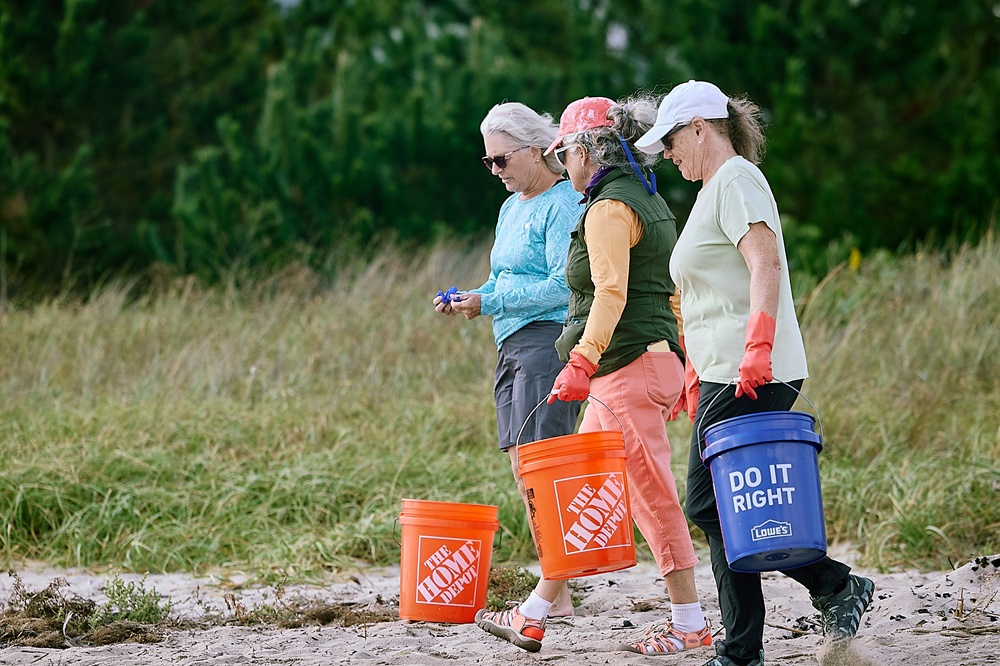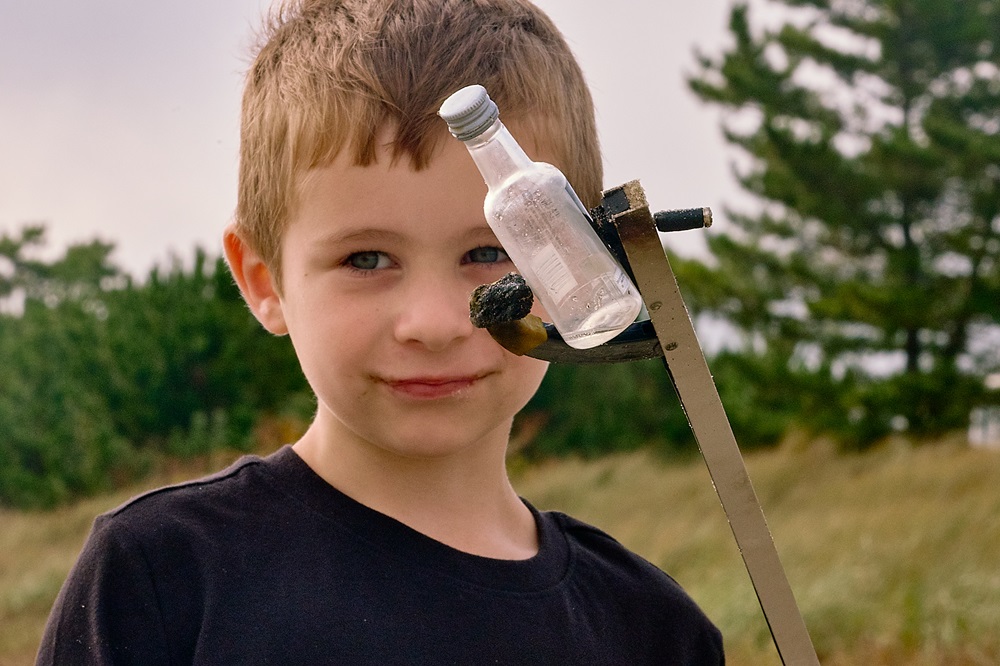Outdoor Delaware is the award-winning online magazine of the Delaware Department of Natural Resources and Environmental Control. Articles and multimedia content are produced by the DNREC Office of Communications.
Every year, millions of people enjoy recreating along the Delaware coast. The state’s award-winning southern beaches draw huge numbers of visitors during the summer months but continue to see guests the rest of the year. While many people visit from out of state, our coastal areas are still popular with residents of the First State, some of whom visit state parks, wildlife areas and beaches on a weekly basis.
Naturally, all that human interaction has some unintended consequences, one of the most visible of which is leftover garbage. Though few people intend to leave trash behind when they’re out enjoying nature, it happens. Old cigarettes, plastic bags and glass bottles are just a few of the most common items that can be found along the shore half-buried under sand or washed up with the tide.

That’s why the Delaware Department of Natural Resources and Environmental Control has since 1987 hosted an annual litter pick-up event. The 2024 Coastal Cleanup, held on Saturday, Sept. 14, saw 947 volunteers at 43 sites across the state. The 2025 event, which took place on Saturday, Sept. 13, had a similar number of participants and resulted in even more trash being cleaned up.
Volunteers in 2024 picked up about 3,500 pounds, or 1.8 tons, of refuse. Among that trash was not just thousands of bottles and food wrappers but vampire teeth, shotgun shells, a rusty anchor, toys, a sink, crab traps and underwear. During the next iteration a year later, volunteers gathered 5,121 pounds (2.6 tons), including car parts, a bean bag chair and around 6,600 cigarette butts.
To Slaughter Beach Vice Mayor Harry Ward, Delaware’s Coastal Cleanup is a labor of love.
Many residents in the small bayside town walk the beach on a weekly basis and pick up trash in the process, he said.
“If you really want pristine beaches, you have to take part in it and put your own efforts into it,” Ward said.
(Delaware DNREC/Lisa Moy)
Delaware’s event is based off an international cleanup effort started by Ocean Conservancy in 1986. Since its inception, more than 18 million volunteers have cleaned up in excess of 190,000 tons of trash around the globe.
Volunteers came out to more than 45 sites up and down the state in 2025, showing their passion for Delaware’s coastal areas. Much of the attention went to Sussex County — no surprise given so much of the coast there consists of popular beaches.
“Coastal cleanups are vital for protecting the natural beauty and health of not only for Delaware Seashore State Park but all coastal areas,” Delaware Seashore State Park Superintendent Lindsey Goebel said. “By removing litter and debris, we help protect local wildlife and preserve these delicate ecosystems, ensuring that marine animals and birds aren’t harmed by discarded waste. Keeping the park clean also prevents pollution from entering the water, which helps maintain the park’s pristine beaches and clean waters. A clean environment ensures that visitors have a safe and enjoyable experience, free from hazardous items like broken glass or other sharp debris. These cleanups promote a sense of stewardship for our parks and other coastal landscapes. It’s everyone’s beach, and when we team up to reach a common goal it’s very rewarding to see the outcome.
“The generosity and time dedicated by volunteers during the coastal cleanup is truly heartwarming. Their efforts help our park staff see remarkable progress in areas we work on daily, transforming them into litter-free spaces within just a few hours. The many helping hands that come together in support of our mission make a meaningful difference, and we are incredibly grateful for their contributions.”
But by no means is the cleanup restricted to the most popular beaches along Lewes, Rehoboth, Dewey, Bethany and Fenwick.
All over the state’s eastern coast, people young and old gathered to seek trash. They came from school clubs, Boy and Girl Scouts, environmental groups and more, with many joining of their own volition simply to do their part in keeping nature clean.

About two dozen volunteers met at 9 a.m. at Fox Point State Park near Bellefonte, where they split into two groups. Most of the people boarded a bus and, accompanied by Amtrak personnel, took a short ride to a marshy area at the water’s edge along the train tracks. There, armed with gloves, buckets and trash grabbers, they walked around looking for anything man-made that didn’t belong. Others at Fox Point, meanwhile, focused their efforts on the park itself, wandering around the small area by the Delaware River in search of loose garbage.
Volunteers at the site found the usual junk — empty water bottles, scraps of paper, bits of plastic and such — as well as an old couch, a basketball and a disconcerting mannequin head.
For some, it was their inaugural Coastal Cleanup, though far from their first time picking up trash in nature.
Bill Berti opted to join out of a fondness for the natural world. He is a frequent visitor of Bellevue State Park and often brings a bag with him in case he spots garbage while exploring the park.
A desire to prevent wildlife from being harmed by discarded man-made products led Brenda Haire to participate.
“I hate to see animals with the six-pack rings” around their necks, she said.
Like Berti, Cindy Curry is a fan of Delaware’s parks, and so she figured she would use a bit of her time on Saturday morning to help at the cleanup.
“If everybody could do it as they go along, I think it would just help improve things,” she said.
As for why the event is important, that was self-evident to Joe Francis, an avid birdwatcher, who simply scoffed when asked why people should take part.
2025 marks just the third time in the past six years a full-scale cleanup has taken place in Delaware. Bad weather canceled the event in 2023 for the first time, while a worldwide pandemic you may have heard of forced organizers to adapt in 2020 and limited the scale of the cleanup in 2021. As a result, for 2020 DNREC encouraged people to clean up trash on their own at a favorite location, such as a beach, park or one’s neighborhood, and share pictures and data with the agency.

Some notable past finds include a car door, propane tanks, tires, animal skulls and even a bag of marijuana. All that junk is bagged up, weighed and disposed of in dumpsters or landfills. In the rare event someone stumbles upon hazardous materials, DNREC’s Emergency Response Team is called. In fact, ordnance from World War II has been found at Cape Henlopen State Park before.
One of the main pluses of the cleanup, according to organizers, is that record-keeping is an important part of the annual event. That enables DNREC to track exactly how much garbage is collected, which can be used to look for trends, provide insight on policy proposals and even connect directly with manufacturers.
“In addition to cleaning up debris along coastlines, another important goal was to document and study the type of trash collected during the cleanup,” said Kim Gould, an environmental program manager with DNREC who has been the site captain at Fox Point for several years. “Documentation included studying the trash’s material, where it could have come from, how long it would take to disintegrate, and what impact it would have on the ocean and the species living in it. This feedback has helped the manufacturing industry re-think packaging.”
When legislators were looking to pass a ban on single-use plastic bags in 2019, DNREC was able to let them know just how many bags had been collected in the most recent Coastal Cleanup, for instance.
That ban, by the way, has had a positive impact since taking effect in 2021, with fewer plastic bags being found during the cleanup, according to organizers.
Ward, the vice mayor of Slaughter Beach, estimated the cleanup typically generates around 100 to 125 pounds of trash from the town, though that seems to be trending down — a sign the cleanup is working.
“I think all of us could use a little bit of community service now and then,” he said.
Editor’s note: This article was published in 2024 and updated in 2025.
Related Topics: coast, coastal, health and science, nature, ocean and coasts, outdoor delaware, volunteer, volunteers